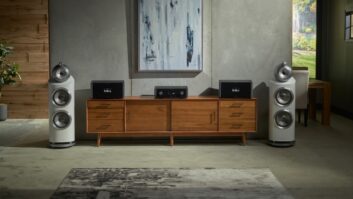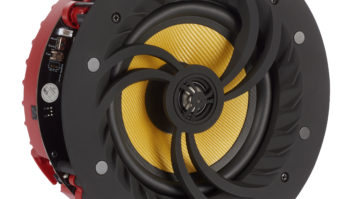NEW YORK – Whether the overall home audio market is flat or posting modest growth, growth segments include anything that connects to the new music sources and connects with consumer’s changing lifestyles.
And though two-channel sales are nowhere near their peak, twochannel audio products are also posting good gains.
TWICE assembled a panel of industry leaders to discuss the trends in component audio, including active soundbars, HTiBs, and tabletop docking speakers.
Here’s what they had to say:
Component Audio Trends
TWICE: How did component audio fare in 2012, and what is the forecast for 2013?
Sumner: Overall component audio was pretty flat in 2012 against 2011 in units and dollars. We aren’t seeing big moves up or down in average selling prices. A/V receivers are down a few percentage points year over year, and speakers are up a few percentage points, with speaker growth coming mostly in architectural speakers. Some of this is due to improved sales in the custom-install channel, which we believe is driven by the improving housing market. We are seeing consumers upgrading audio systems in existing homes, and homeowners in new homes adding entertainment. We believe that the overall level of A/V receivers is being somewhat affected by lower flat-panel display sales in the retail channel and by a shift in consumer preference for soundbar systems to amplify TV, especially in secondary rooms.
Manowitz: Overall Sony is seeing growth in home audio. While some categories are significantly growing, like soundbars, we are also experiencing strong sales from stable categories, like receivers, and even within declining legacy categories.
Poggi: Sales have increased in 2012. Improved product features and performance, as well as new products and new distribution, have all contributed to growth. We believe this trend will continue in 2013.
TWICE: Any shifts in the price ranges that sold well in component electronics and speakers in 2012, and expectations for 2103?
Sumner: The main shift we saw in receivers in 2012 was that the $200 to $300 price point attracted more consumers, and we saw demand across the $300 to $600 price points spread out, but not really shift. The main reason we believe was that receivers with network capabilities fell into the $300-plus range in 2012, so consumers who did not want networking pushed themselves below $300, and those that wanted networking had a wide range of choices over that price point. We also saw good increases in AVR sales in the $600 to $1,100 range.
Manowitz: For receivers, we saw some increases in average selling price due to strong consumer demand for connecting mobile devices. For soundbar and other legacy categories, we saw a stable price trend.
Poggi: AVRs priced at $1,200 and above are enjoying a strong comeback, and that also includes models priced above $2,000. The expectation was that sales of AVRs in the $500 to $600 range would be challenged as more features (including networking) made their way to sub-$400 price points. However, demand for models priced above $500 remains strong. On the loudspeaker front, soundbars above $500 are extremely strong, and it looks like this demand will continue into FY13.
TWICE: How did component-audio retail margins fare in 2012, and what’s the forecast for 2013?
Sumner: The dealers we talk with have seen their margins at retail increase in audio. The major factors seem to be better inventory management on the part of dealers, requiring fewer closeouts, and strong new products with AirPlay, networking, i-control and other features that consumers appear to believe are a very good value at the prices at which they are offered.
Poggi: Margins increased as programs such as MAP, UAP and UMAP have been implemented and enforced. As more programs like these come into play, the prospects for 2013 look even better, as both manufactures and dealers will better understand how to utilize them to their advantage.
TWICE: What features were in demand in receivers in 2012?
Sumner: Even though all Yamaha receivers have 4K passthrough or up-scaling as sort of a “future proof” feature, the customers who bought AVRs in 2012 didn’t have 4K (UltraHD) on their minds. From our customers, the two key features driving consumer demand were wireless connections at all price points, and secondzone HDMI at the higher price points. Wireless control via iOS and Android apps and wireless streaming, like Yamaha MusicPlay and Apple AirPlay, were high on customer’s reasons for purchasing a new AVR. With more than 50 percent of phones in the U.S. now a smartphone, customers want to be wireless, not tethered, almost all the time. That said, we don’t see MHL as a big driver for customers in 2012 or in 2013. Better sound quality and second-zone HDMI appeared to be big drivers for consumers buying AVRs in the over- $700 range.
Manowitz: We are seeing a continued desire from consumers to have flexibility and simplicity in connecting their A/V receiver to digital content. This comes in a variety of flavors and includes connecting their smartphones and tablets via Bluetooth and AirPlay. But there is also the desire to directly stream using built-in services, and consumers want it to be easy and wireless. So consumers are willing to step up when it is built in, and we can make it easy.
Poggi: Networking was the No. 1 demand feature in receivers for 2012, mainly because it opens the door to so many capabilities like AirPlay, app control, music and photo streaming. It’s also a hedge against obsolescence, thanks to the access it offers for automatic updating. Additionally, as awareness of 4K video grew, the ability to both scale to 4K and passthrough native content became more compelling for consumers.
TWICE:What new features do you see coming to receivers in 2013, or what features will proliferate to lower price points?
Sumner: Streaming services continue to gain in popularity, and we expect to see more streaming services included and updated at lower price points on network receivers. For home-control brains being built-in to receivers, Yamaha works to make certain our network receivers, especially in the Aventage series, are ready to integrate with all the major home-control systems. We’ll continue to do that. Including a homecontrol system chipset in a receiver really limits it to those that want to integrate it into that particular system. We think the better way for the customer is to get the home-control system that works best for their situation, then be able to select a receiver that meets their installation needs.
Manowitz: We expect consumers to continue to demand having more connectivity options and for receivers to continue to become more powerful. The launch of our Sony ES receivers with built-in home automation is a great example of providing this power. More great things will come in 2013.
Poggi: Networking will continue to expand into new (and lower-priced) models, as will improved GUIs and setup menus. In addition, 4K scaling will be another feature found in lower-priced receivers. In the upperend AVR arena, the number of channels processed will shift from seven to nine and even to 11 and beyond. The number of actual amplifier channels will also continue to increase. Improvements and enhancements to surround-sound processing will begin to find their way into higher-end AVRs, and it’s safe to assume that the AVR will continue to expand its processing power and offer improved system and home control as well.










